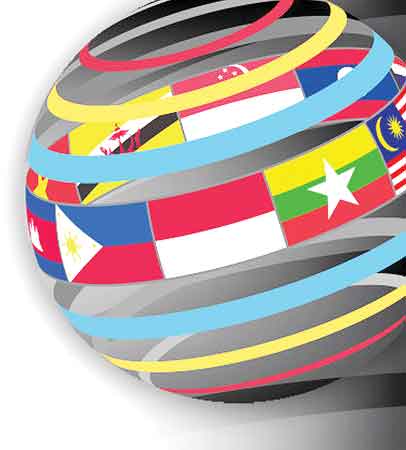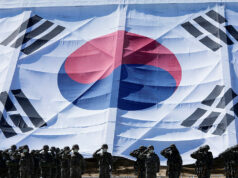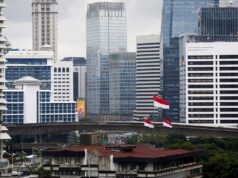Politics and Crisis: A Discussion SeriesRe-imagining ASEAN in a time of crisis
By the Ateneo de Manila Department of Political Science
(Part 4 of an eight-part series)
WITH AROUND 650 million inhabitants and a land area covering 4.5 million kilometers, the Southeast Asian region is home to the world’s ninth largest economy and a diverse set of cultures, beliefs, and political systems. The region also contains the busiest international sea and trade routes in the world. The way the Association of Southeast Asian Nations (ASEAN) handles the crisis will have implications, not just on its member-states, but the world.
We argue on two points: First, now more than ever, there is an immediate need for the 10 member states to come up with an integrated and well-coordinated response to adequately address the COVID-19 pandemic. Secondly, this integrated response offers an opportunity for the ASEAN to expand substantive measures to further integrate the region once the crisis is over.
ASEAN RESPONSES: CONVERGENCE OR DIVERGENCE?
One major trend taking place within the region is how each nation has tried to “flatten the curve” of the pandemic with travel bans and border lockdowns.
For instance, as early as January, Brunei started imposing entry restrictions for travelers coming from Hubei province. While those coming from other parts of China were allowed entry into the sultanate, they were required to follow a strict two-week self-quarantine upon arrival. A total entry ban for all foreign nationals took effect starting March 24, while citizens and residents needed to secure the Office of the Prime Minister’s permission before leaving the country.
Like Brunei, Indonesia also imposed a travel ban to and from China on Feb. 5 to curb the spread of the disease. This was followed by more travel restrictions for countries like South Korea, Italy, Iran, Spain, France, Germany, Switzerland and the United Kingdom. Despite declaring the pandemic as an “unnatural national disaster,” the Jokowi administration refused to impose a national lockdown and instead implemented “large-scale social restrictions” on its people. This decision has sparked some controversy between the central and local governments, given that regional leaders have begun introducing measures to control movement within their own territories.
Malaysia’s response paints a totally different picture. A partial lockdown was implemented on March 18 in the form of a “movement control order (MCO),” a sanitary cordon that restricts the movement of its citizens. While the delivery of food and basic necessities remained unhampered, road block operations manned by military personnel were set up across the country to monitor cross-border business and activities. Just two days before, on March 16, a similar decision was adopted by the Philippines, placing the entire island of Luzon under “enhanced community quarantine (ECQ)” until April 14. Following President Duterte’s announcement of a state of public health emergency on March 8, the ECQ resulted in the closing of ports and terminals, the cancellation of work and classes in offices and universities, the installation of checkpoints, and the disruption of the public transport system.
According to Prime Minister Muhyiddin Yassim, while the MCO has successfully reduced the spread of COVID-19, the Malaysian government has decided to extend it until April 18 based on the advice given by medical specialists and the Ministry of Health. Similarly, last week, President Duterte confirmed that the ECQ would be extended until the end of April. It is interesting to note, however, that mass testing will only commence on April 14, the original date for the lifting of the ECQ.
Singapore took on a more drastic turn last week when Prime Minister Lee Hsien Loong announced that the city-state will be implementing a partial month-long lockdown starting April 7 until May 4. Essential businesses and key services will remain available during this “circuit breaker” period, work and online learning will continue at home. Trains and buses have remained operational, but the holding of public gatherings and other social events has been banned.
In other parts of mainland Southeast Asia, various governments have similarly turned to lockdowns and other drastic measures to contain the spread of the disease.

Starting March 17, Cambodia’s Ministry of Health implemented an entry ban for foreigners traveling from Italy, Germany, Spain, France, and the US for a month. Last week, the government announced that it will be shutting down all its district and provincial borders for a week, from April 9 to 16. On March 29, Myanmar (which has been initially accused of underreporting COVID-19 cases within its borders) initiated stricter preventive measures, banning incoming flights until April 13 (and further extending it to April 30), and cancelling the week-long Thingyan New Year celebration this week. The following day, March 30, Laos announced that it will also close off its international and provincial borders for three weeks.
On April 1, Vientamese Prime Minister Nguyen Xuan Phuc signed a decree classifying COVID-19 as a “Class A” contagious disease, elevating it to the level of a nationwide epidemic. He then announced a 15-day period of home quarantine and social distancing across the whole country. Two days after, the Thai government imposed a nationwide curfew to encourage its citizens to stay at home and avoid social gatherings. In a televised speech, Prime Minister Prayuth Chan-o-cha stressed the importance of prioritizing the nation’s health over individual freedom. This is the latest step the Thai government has taken since Bangkok was placed under partial lockdown on March 22 and an Emergency Decree empowered the current administration to turn to draconian measures in controlling movement and free speech.
ASEAN AS A PLATFORM FOR CONVERGENCE: CAUGHT BY SURPRISE?
The responses of each individual nation-state under the ASEAN bloc exposes the lack of any meaningful regional integration in the bloc. In other words, this crisis reveals the different “governing biases” of the ASEAN bloc, and this brings about important questions that should be settled if the bloc is at all serious about the prospects of greater regional integration.
The need for greater cooperation and integration is not lost on ASEAN. On April 7, ASEAN Health Ministers released a joint statement recognizing the need for “active engagement and cooperation among ASEAN Member States, with various stakeholders through a whole-of-government and whole-of-society approach, and the pro-active and timely action of the ASEAN Health Sector in the collective response towards COVID-19.” On April 14, ASEAN Leaders held a Virtual Summit specifically to talk about COVID-19, with each leader echoing the same sentiments. But what are the possible issues and problems that might hinder this cooperation and integration in the long fight against this pandemic and future crises?
The first problem is that while there are indicators of regional integration and cooperation at the economic level with the establishment of the ASEAN Economic Community (AEC) in 2015, there is a lack of an integrated response in border closings, containment measures, the transportation of food and other basic necessities, (i.e. the humanitarian and diplomatic facet of the response). However, the exchange of goods and aid in this crisis still remains a largely bilateral, rather than regional affair. Those seriously looking into the prospects of greater ASEAN integrations should therefore ask why ASEAN (and in fact, the world), seemed to be caught by surprise by the spread of COVID-19 given that the region was largely expected to be more prepared for pandemics given its history with previous outbreaks and the institutions for addressing these concerns are already in place. If it is because of the nature of the disease to be more contagious than previous types of outbreaks, current protocols and institutions that deal with non-traditional security issues must be adjusted to address these kinds of concerns that have a higher level of rapidity than usual.
This means that the role of the ASEAN Risk Communication Resource Centre and the ASEAN Coordinating Center for Humanitarian Assistance needs to be clarified, assessed, and strengthened if we are able to more efficiently respond to future humanitarian crises. In terms of integration at the healthcare front, the ASEAN can lean on the institutions already put in place when the region was also hit by the SARS and Avian Influenza epidemics. There are already mechanisms in place, such as the Protocol for Communication and Information Sharing on Emerging Infectious Diseases, the Regional Multi-Sectoral Pandemic Preparedness Strategic Framework, and the ASEAN Minimum Standards on Joint Multi-sectoral Outbreak Investigation and Response that the ASEAN can lean on and reassess in light of the current pandemic. Other structures, such as the ASEAN Coordinating Center for Humanitarian Assistance and the ASEAN Plus Three (APT) Field Epidemiology Training Network formed during previous disease outbreaks in the regions must also be expanded and improved.
Second, Beijing’s growing influence on the region also remains an important question. Beijing’s aggressive charitable push in order to change global perceptions on its responsibility over the spread and handling of the pandemic will raise the prospect of further ASEAN integration in the future. Hurrell (2004) says that regional institutions are “not just concerned with liberal purposes of solving common problems or sharing shared values. They are also sites of power and reflect and entrench power hierarchies and the interests of powerful states.” The question still remains as to the extent that each member-states’ relationship with Beijing accounted for the timing and nature of each country’s initial response to the pandemic. There is also the greater, more long-term question if it is Beijing which will define the terms of greater cooperation in the region owing to its growing influence over the domestic affairs of ASEAN member states, or if ASEAN can serve its own interests and soften Beijing’s influence over the region. This certainly puts the ASEAN in a tight spot. In fact, the pandemic weakens an already fraught possibility of any joint actions in the region to respond to the crisis and instead shows that the region is still very much vulnerable to the power politics of major players outside of it.
Recently, this sentiment was echoed by the European Union’s Minister for Foreign Affairs Josep Borrel when he took note that the political tussle between the United States and China on the pandemic must also be seen as containing “a geo-political component including a struggle for influence through spinning and the ‘politics of generosity’.” The EU, being a highly-integrated region, was also hit hard by the pandemic and serves as a good starting point to study the successes and failures of pandemic response at a regional level. He states that: “It is vital that the EU shows it is a Union that protects and that solidarity is not an empty phrase. After the first wave in which national authorities took center stage, now the EU is coming to the fore with joint actions on all tracks where member states have empowered it to act: with joint procurement of vital medical equipment, with a joint economic stimulus and a necessary relaxation of fiscal and state aid rules.”
REIMAGINING ASEAN IN A TIME OF CRISIS
The prospects of greater political regionalism and economic integration requires a fundamental re-imagination of the values and norms that will govern the ASEAN. The old norms of “non-interference” and “non-confrontation” when dealing with transnational issues have proved to be largely ineffective in addressing not just COVID-19 but previous issues such as the territorial disputes regarding the West Philippine Sea and the Rohingya refugee crisis.
A new regional compact needs to be forged in a post-COVID ASEAN. Strong national leaderships can only go so far. This crisis opens the possibility that beyond the coordination on trade and the flow of goods, institutions such as healthcare, labor, social welfare, and education are global concerns and also need to be seriously discussed at a regional level. Therefore substantive new regional standards can be put in place and issues of regional power players need to be addressed in order to push the ASEAN into a direction of greater political integration, crisis context or otherwise.
This will not be the last major crisis that will hit the region and the rest of the world as bigger issues such as climate change will need more coordinated action. The time is ripe for reform, re-invention, and greater integration, as the world deals with a disrupted status quo and prepares for a new geo-political landscape.



